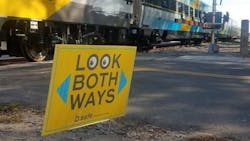Editor's Notebook: Jolting awareness into rail crossing safety
At a previous stage in my career, I was a regular attendee at a freight rail-focused conference where a Class 1 railroad engineering representative would start his annual presentation with a series of truly shocking videos taken from inside the cab of a locomotive during accidents at grade crossings caused by careless vehicle drivers. There were logging trucks, semis, waste hauling vehicles and others – he never ran out of new material. Even though I knew prior to viewing there was no loss of life, the sound of impact, the swooshing of the emergency brakes and the seemingly endless time between impact and when the train stopped remain with me.
A similar video was released last month by Brightline showing an incident in Lake Worth Beach, Fla. Viewers of the minute-long video see the moment a freight train exits a crossing on the adjacent track and a small car drives past lowered gates and into the path of the Brightline train. The driver survived. However, as The Miami Herald Editorial Board wrote shortly after the video’s release, “If we had any doubt that South Florida has a problem with train accidents, the video erased it.”
Florida is consistently among states with the most grade-crossing incidents and the Federal Railroad Administration (FRA) reports the state’s five-year average is 2.84 incidents per grade crossing compared to 1.51 nationally.
The Palm Beach County Sheriff’s Office increased patrols along the railroad tracks where the incident above took place to educate drivers and pedestrians about safety around railroad property. Over the span of two weeks, the sheriff’s office issued 226 traffic citations, 233 written warnings and 76 verbal warnings.
This recent increase in incidents in South Florida prompted FRA to call a Rail Safety Town Hall with representatives from the Federal Highway Administration, Brightline, Florida East Coast Railway, South Florida Regional Transportation Authority, Amtrak, CSX and regional city and county officials. FRA says the discussion centered around lessons learned, prevention measures and areas for improvement.
FRA Staff Director of Grade Crossing and Trespass Outreach James Payne noted the challenge is a shared responsibility and said it would take “all of us” to find a solution. This is a belief also held by FRA Administrator Amit Bose, who stressed “we must discourage trespassing and encourage pedestrians and motorists to always obey signs and signals along the railroad right of way and to always expect a train. We must work as one to save lives.”
Let’s work to find the right combination of education, engineering and enforcement to solve this industry-wide challenge or we will never run out of these horrific videos.
About the Author

Mischa Wanek-Libman
Group Editorial Director
Mischa Wanek-Libman is director of communications with Transdev North America. She has more than 20 years of experience working in the transportation industry covering construction projects, engineering challenges, transit and rail operations and best practices.
Wanek-Libman has held top editorial positions at freight rail and public transportation business-to-business publications including as editor-in-chief and editorial director of Mass Transit from 2018-2024. She has been recognized for editorial excellence through her individual work, as well as for collaborative content.
She is an active member of the American Public Transportation Association's Marketing and Communications Committee and served 14 years as a Board Observer on the National Railroad Construction and Maintenance Association (NRC) Board of Directors.
She is a graduate of Drake University in Des Moines, Iowa, where she earned a Bachelor of Arts degree in Journalism and Mass Communication.
